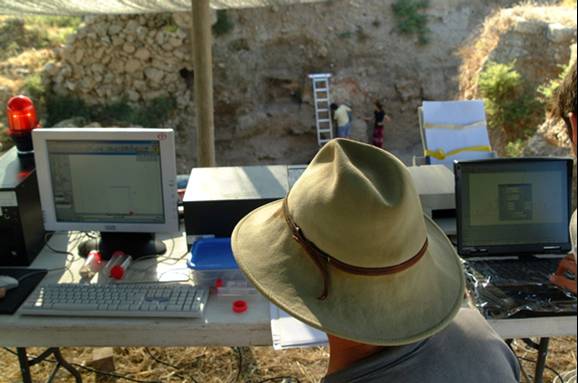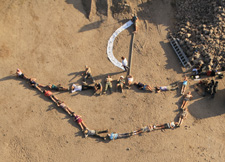Sediment Analysis
Research at Dor by the Kimmel Center for Archaeological Sciences group at the Weizmann Institute
 The sediments that are deposited during site occupation,
after occupation and by natural processes, can all provide
information about the archaeology. Their analysis begins
with careful field observations on-site using a combination
of field observations, with on-site analyses of the nature
of the sediment mineral, morphological and elemental analyses.
We operate a portable laboratory located right next to the
excavation area under investigation. We use X-ray
fluorescence to analyze for mainly heavy metal concentrations,
infrared spectrometry to identify mineral and organic
components of the sediments and a petrographic microscope.
These analyses take only a few minutes and allow for the
initial investigation of the site in real time as the
excavation is underway.
The sediments that are deposited during site occupation,
after occupation and by natural processes, can all provide
information about the archaeology. Their analysis begins
with careful field observations on-site using a combination
of field observations, with on-site analyses of the nature
of the sediment mineral, morphological and elemental analyses.
We operate a portable laboratory located right next to the
excavation area under investigation. We use X-ray
fluorescence to analyze for mainly heavy metal concentrations,
infrared spectrometry to identify mineral and organic
components of the sediments and a petrographic microscope.
These analyses take only a few minutes and allow for the
initial investigation of the site in real time as the
excavation is underway.
This is followed up with analyses in the laboratories at the Weizmann Institute, often with frequent visits to Dor during the period between excavations. The following are examples of the analyses we perform in the laboratory:
-
Micromorphology - blocks of intact sediments are embedded in a plastic and cut into very thin sections for analysis of the in situ structures. This provides information on the site formation processes and occupation modes. Mineral components that cannot be identified in this way are subjected to elemental analysis using the EDS attachment of the scanning electron microscope. Performed by Ruth Shahack-Gross.
-
Phytolith analysis
Phytoliths (opal plant microremains) are ubiquitous at some archaeological levels from Dor. Infrared analyses have identified the main mineralogical component of quite a few floor-surfaces as opal, which according to the preliminary microscopical observation, corresponds to opal phytoliths. They are thus the main indicators for the botanical facies of the archaeological record of the site.
Plants either grew natuarally on the site; were brought there as human food, animal fodder, fuel, artefacts (sacks, baskets, mats etc.) or building materials; or their remains were discarded in the form of animal dung (which, again, may have been reused as fuel or construction material).The study focuses on the identification of plant types and plant parts present in the archaeological sediments through a detailed morphometric and quantitative analyses of phytoliths. Refractive Index of phytoliths is also being checked to determine whether the plants had been burnt. The main purpose of the work carried out by Dr. Albert is to obtain a better knowledge on the use of plants, for different purposes, by the people living at the site - what plants were being brought in, in what form, at which part of their life-cycle. Careful mapping of these data, together with the archaeological contexts at which they were found can be a powerful tool on reconstructing human exploitation of the natural habitat as well as the type of use of specific activity areas on site.
- Pyrotechnology - infrared analyses point to large volumes of tel sediments having been burned in one way or another. The changes in the minerals are examined by Raman and infrared spectroscopy, thermogravimetric analyses and with electron microscopes. Simulation experiments performed both on the tell and in the laboratory with local sediments are carried out to determine likely scenarios for the burning. Performed by Francesco Berna and Adi Bahar.
